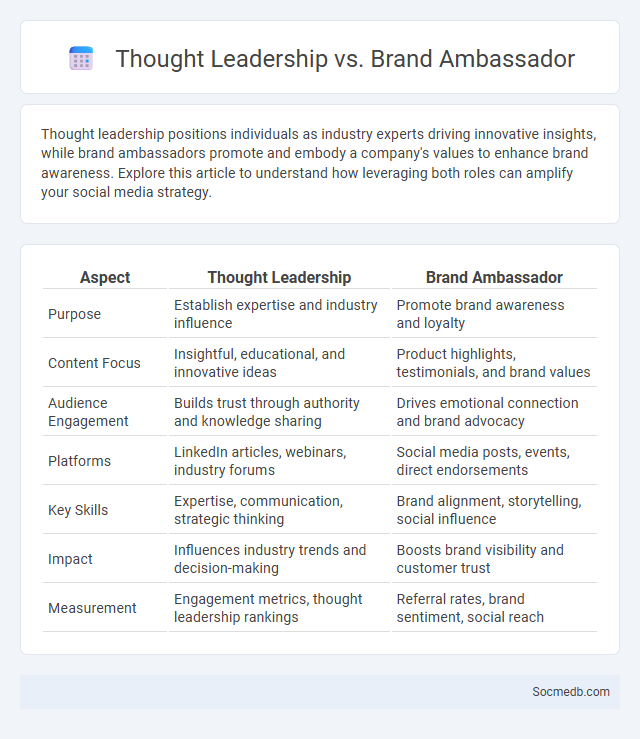
Photo illustration: Thought Leadership vs Brand Ambassador
Thought leadership positions individuals as industry experts driving innovative insights, while brand ambassadors promote and embody a company's values to enhance brand awareness. Explore this article to understand how leveraging both roles can amplify your social media strategy.
Table of Comparison
| Aspect | Thought Leadership | Brand Ambassador |
|---|---|---|
| Purpose | Establish expertise and industry influence | Promote brand awareness and loyalty |
| Content Focus | Insightful, educational, and innovative ideas | Product highlights, testimonials, and brand values |
| Audience Engagement | Builds trust through authority and knowledge sharing | Drives emotional connection and brand advocacy |
| Platforms | LinkedIn articles, webinars, industry forums | Social media posts, events, direct endorsements |
| Key Skills | Expertise, communication, strategic thinking | Brand alignment, storytelling, social influence |
| Impact | Influences industry trends and decision-making | Boosts brand visibility and customer trust |
| Measurement | Engagement metrics, thought leadership rankings | Referral rates, brand sentiment, social reach |
Introduction to Thought Leadership and Brand Ambassadors
Thought leadership establishes your brand as an authoritative voice by sharing expert insights and innovative ideas that resonate with your target audience. Brand ambassadors enhance this strategy by authentically promoting your values and products, creating trust and expanding reach through genuine connections. Leveraging both elements effectively can amplify your social media presence and position your business as a trusted industry leader.
Defining Thought Leadership: Key Characteristics
Thought leadership on social media is defined by consistently sharing original insights, expert knowledge, and innovative ideas that resonate with a targeted audience. Key characteristics include authenticity, authority in a specific niche, and the ability to inspire meaningful engagement through valuable content. Establishing trust and demonstrating thought leadership fosters community growth and positions individuals or brands as influential voices within their industry.
What is a Brand Ambassador? Roles and Responsibilities
A Brand Ambassador represents and promotes a company's products or services, enhancing brand awareness and customer loyalty through authentic interactions on social media platforms. Their responsibilities include creating engaging content, sharing positive experiences, and influencing their audience to build trust and drive sales. You can leverage a Brand Ambassador's genuine connection with followers to amplify your brand's reach and impact effectively.
Core Differences: Thought Leader vs. Brand Ambassador
Thought leaders use social media to share expert insights and innovative ideas, aiming to influence industry trends and build a personal reputation rooted in authority. Brand ambassadors leverage social media to promote a company's products or services, fostering brand loyalty by representing the company's values and engaging with target audiences. The core difference lies in thought leaders prioritizing expertise and original content, while brand ambassadors emphasize brand alignment and direct product endorsement.
Impact on Brand Reputation and Authority
Social media significantly influences brand reputation by enabling direct interaction with customers, amplifying both positive feedback and negative criticism in real time. Consistent engagement and quality content across platforms build brand authority, fostering trust and loyalty among target audiences. Managing social sentiment and swiftly addressing issues reinforces credibility and strengthens long-term market positioning.
Strategies for Leveraging Thought Leadership
Developing a strong content strategy that consistently showcases industry expertise enhances credibility and attracts a targeted audience on social media platforms. Engaging with niche communities through meaningful discussions and sharing insights fosters trust and positions the brand as a go-to resource. Utilizing data-driven analytics to refine messaging and identify trending topics ensures content remains relevant and maximizes thought leadership impact.
Harnessing the Power of Brand Ambassadors
Harnessing the power of brand ambassadors magnifies social media reach by leveraging authentic voices that resonate with target audiences. These ambassadors create trust and credibility, driving higher engagement and conversion rates through personalized content and genuine endorsements. Effective brand ambassador programs integrate user-generated content and influencer partnerships to amplify brand visibility and foster community loyalty.
Choosing Between Thought Leadership and Brand Ambassadors
Choosing between thought leadership and brand ambassadors hinges on your business goals and audience engagement strategy. Thought leadership establishes your brand as an industry expert, driving trust and influence through insightful content and expert opinions. Brand ambassadors amplify your reach by leveraging authentic customer experiences and personal connections, creating a relatable and trusted voice around your products or services.
Integrating Both for Maximum Brand Impact
Integrating social media platforms like Instagram and LinkedIn amplifies your brand's reach by combining visual storytelling with professional networking. Tailoring content to the unique strengths of each platform enhances audience engagement and drives targeted traffic. Effective cross-platform strategies ensure consistent messaging, boosting brand awareness and maximizing impact across diverse user bases.
Measuring Success: ROI of Thought Leadership vs. Brand Ambassadors
Measuring success on social media involves distinct metrics for thought leadership and brand ambassadors, with thought leadership emphasizing content engagement, audience reach, and influence in niche communities. Brand ambassadors focus on conversion rates, customer acquisition costs, and overall impact on sales attributed to authentic endorsements. A comprehensive ROI analysis combines these quantitative measures with qualitative assessments of brand loyalty and long-term audience trust.
 socmedb.com
socmedb.com